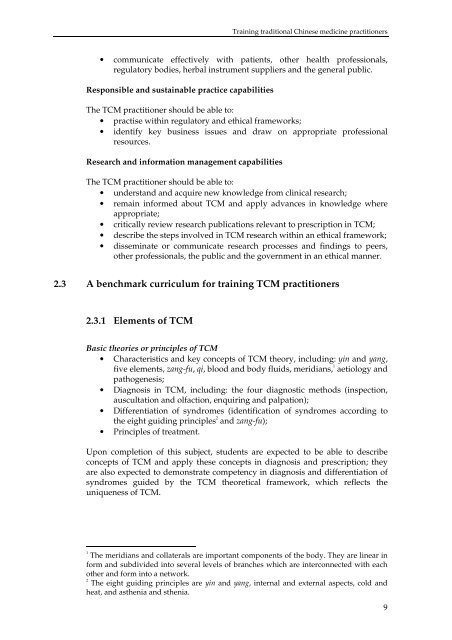Benchmarks for Training in Traditional Chinese Medicine
Benchmarks for Training in Traditional Chinese Medicine
Benchmarks for Training in Traditional Chinese Medicine
You also want an ePaper? Increase the reach of your titles
YUMPU automatically turns print PDFs into web optimized ePapers that Google loves.
<strong>Tra<strong>in</strong><strong>in</strong>g</strong> traditional Ch<strong>in</strong>ese medic<strong>in</strong>e practitioners• communicate effectively with patients, other health professionals,regulatory bodies, herbal <strong>in</strong>strument suppliers and the general public.Responsible and susta<strong>in</strong>able practice capabilitiesThe TCM practitioner should be able to:• practise with<strong>in</strong> regulatory and ethical frameworks;• identify key bus<strong>in</strong>ess issues and draw on appropriate professionalresources.Research and <strong>in</strong><strong>for</strong>mation management capabilitiesThe TCM practitioner should be able to:• understand and acquire new knowledge from cl<strong>in</strong>ical research;• rema<strong>in</strong> <strong>in</strong><strong>for</strong>med about TCM and apply advances <strong>in</strong> knowledge whereappropriate;• critically review research publications relevant to prescription <strong>in</strong> TCM;• describe the steps <strong>in</strong>volved <strong>in</strong> TCM research with<strong>in</strong> an ethical framework;• dissem<strong>in</strong>ate or communicate research processes and f<strong>in</strong>d<strong>in</strong>gs to peers,other professionals, the public and the government <strong>in</strong> an ethical manner.2.3 A benchmark curriculum <strong>for</strong> tra<strong>in</strong><strong>in</strong>g TCM practitioners2.3.1 Elements of TCMBasic theories or pr<strong>in</strong>ciples of TCM• Characteristics and key concepts of TCM theory, <strong>in</strong>clud<strong>in</strong>g: y<strong>in</strong> and yang,five elements, zang-fu, qi, blood and body fluids, meridians, 1 aetiology andpathogenesis;• Diagnosis <strong>in</strong> TCM, <strong>in</strong>clud<strong>in</strong>g: the four diagnostic methods (<strong>in</strong>spection,auscultation and olfaction, enquir<strong>in</strong>g and palpation);• Differentiation of syndromes (identification of syndromes accord<strong>in</strong>g tothe eight guid<strong>in</strong>g pr<strong>in</strong>ciples 2 and zang-fu);• Pr<strong>in</strong>ciples of treatment.Upon completion of this subject, students are expected to be able to describeconcepts of TCM and apply these concepts <strong>in</strong> diagnosis and prescription; theyare also expected to demonstrate competency <strong>in</strong> diagnosis and differentiation ofsyndromes guided by the TCM theoretical framework, which reflects theuniqueness of TCM.1The meridians and collaterals are important components of the body. They are l<strong>in</strong>ear <strong>in</strong><strong>for</strong>m and subdivided <strong>in</strong>to several levels of branches which are <strong>in</strong>terconnected with eachother and <strong>for</strong>m <strong>in</strong>to a network.2The eight guid<strong>in</strong>g pr<strong>in</strong>ciples are y<strong>in</strong> and yang, <strong>in</strong>ternal and external aspects, cold andheat, and asthenia and sthenia.9

















